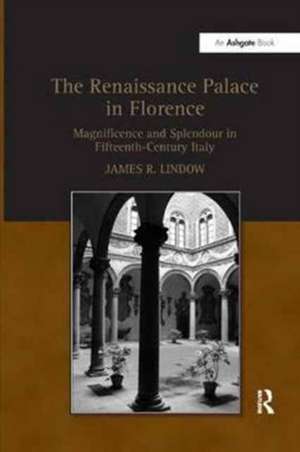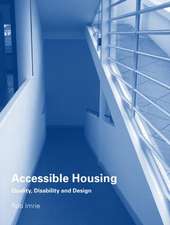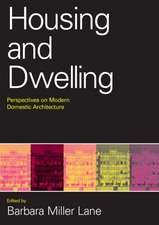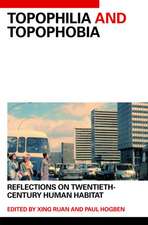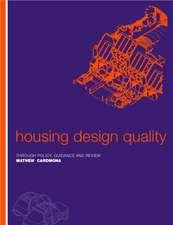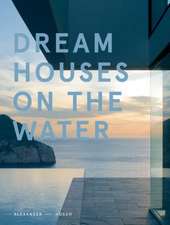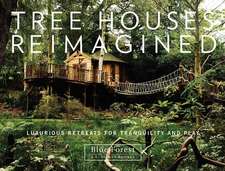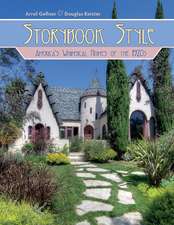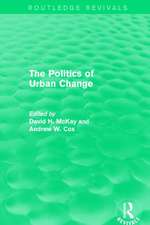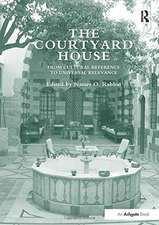The Renaissance Palace in Florence: Magnificence and Splendour in Fifteenth-Century Italy
Autor James R. Lindowen Limba Engleză Paperback – 31 mar 2017
| Toate formatele și edițiile | Preț | Express |
|---|---|---|
| Paperback (1) | 259.98 lei 43-57 zile | |
| Taylor & Francis – 31 mar 2017 | 259.98 lei 43-57 zile | |
| Hardback (1) | 825.43 lei 43-57 zile | |
| Taylor & Francis – 14 iun 2007 | 825.43 lei 43-57 zile |
Preț: 259.98 lei
Preț vechi: 334.03 lei
-22% Nou
Puncte Express: 390
Preț estimativ în valută:
49.76€ • 54.07$ • 41.83£
49.76€ • 54.07$ • 41.83£
Carte tipărită la comandă
Livrare economică 21 aprilie-05 mai
Preluare comenzi: 021 569.72.76
Specificații
ISBN-13: 9781138265479
ISBN-10: 1138265470
Pagini: 286
Dimensiuni: 156 x 234 x 18 mm
Greutate: 0.45 kg
Ediția:1
Editura: Taylor & Francis
Colecția Routledge
Locul publicării:Oxford, United Kingdom
ISBN-10: 1138265470
Pagini: 286
Dimensiuni: 156 x 234 x 18 mm
Greutate: 0.45 kg
Ediția:1
Editura: Taylor & Francis
Colecția Routledge
Locul publicării:Oxford, United Kingdom
Cuprins
Contents: Preface; Introduction; Debated concepts: magnificence and splendour; The classical and medieval precedents for magnificence; The magnificence debate in 15th-century Florence; The currency of the magnificence debates in 15th-century Florence. Magnificent architecture; The motivation to build: for God, for the city and for oneself; Exemplary magnificence: building anew in the antique style; The principle of decorum in the architectural treatises of Alberti and Filarete. Going beyond the palace façade; Connecting the interior and exterior; The accessibility of the palace and its spaces; Magnificent hospitality in the splendid interior. The splendid interior; Rooms and their functions; Furniture and display in the splendid interior; La camera bella: the room made beautiful through domestic display. Conclusion; Appendices; Gabriello di Messer Bartolomeo Panciatichi (1430); I Gismondo di Messer Agniolo della Stufa (1495); The 'camera bella' of Lorenzo di Giovanni Tornabuoni (1497) Bibliography; Index.
Notă biografică
James R. Lindow was the first Renaissance PhD from the Royal College of Art / Victoria & Albert Museum, and completed his MA in the History of Art and Architecture at the University of East Anglia. He has convened conferences and published articles on diverse aspects of the Renaissance, lectures widely in the UK and overseas, and is currently a fine art underwriter in the city of London.
Recenzii
’A great achievement. This book re-establishes links between classical revival and Renaissance material culture, and demonstrates for the first time the close relationship between the 'magnificence' of Renaissance palaces and the 'splendour' of their interiors... Teachers, students, and the general reader will find this book a pleasure to read.’ Alison Brown, Royal Holloway, University of London
’This is a timely publication that reflects the burgeoning scholarly interest in Italian Renaissance domestic buildings - inside as well as out. The book's great novelty lies in its focus on the Florentine palace as an integrated whole and establishes an interesting relationship between these buildings' interiors and exteriors.’ Patricia Allerston, National Galleries of Scotland
’... hitherto unpublished inventories, private documents and surviving domestic objects are used to focus on the Florentine palace as in integrated whole and show the interiors as a series of splendid spaces where virtuous expenditure was displayed.’ The Oxford Times
'Maybe the most outstanding characteristic of Lindow's excellent study is the meticulous logic of his book's structure... While 'magnificence' has been a widely debated concept, Lindow makes a truly original - and necessary - contribution to the field by moving his discussion 'beyond the palace facade'... strong claims to become essential reading.’ The Art Book
’The book as a whole comes across as a profound reappraisal of a largely neglected area of Florentine Renaissance life, and a valuable corrective to the more superficial view of the city's great buildings as being merely some kind of wilful self-indulgence.’ The Art Newspaper
'Teachers, students, and general readers will find this book useful for its synthesis of the theoretical underpinnings of magnificent architecture and splendid interior decoration in Renaissance Florence... the book will be welcome in courses on Renaissance architecture, and its clear prose and straightforward presentation will prove useful to any instructor faced with explaining Neo-Aristotelian theories of magnificence and splendor and their manifestations in the visual culture of Renaissance Florence.' Renaissance Quarterly
'In The Renaissance Palace in Florence Lindow has provided a great service to all students of Renaissance architecture, art and material culture. He has given the theory and the practice of magnificence and splendour the sustained and unified treatment which they have long needed.' Art History
'This book helps one to understand the difficulties encountered by the Medici and other Florentine families when contemplating building a new palace... an interesting and useful book, bringing together architectural, political, social and cultural history in a particularly appealing way.' Burlington Magazine
'[Lindow's] excellent book details the ideological and cultural underpinnings of the Florentine palace and its attendant visual and material cultures... Lindow [...] is the first to devote a book to the big ideological questions surrounding Florentine palaces... Throughout, we are the beneficiaries of Lindow's valiant embrace of the archive. He has jammed his book full with expertly chosen passages from the primary sources he has unearthed... we now have a convenient secondary source that presents us with the discourse on magnificence and splendor in higher resolution than ever... insightful and provocative, and makes us want more.' Speculum
'... likely to remain [a] classic[...] in [its] field for some time... contribute[s] enormously to our understanding of the ways that space, interior and exterior, public and private, were being reconceptualised in this period... One of the main virtues of James Lindow's work is the careful empirical analysis of a number of different sources... Both for general readers and specialists in fourteenth and fifteenth century studies, the work of Lindow offers us a strong foundation on which to build our future research.' Oxford Art Journal
'The scale and chronological range of Lindow's research is impressive... Lindow does a marvellous job of allowing the documents to speak for themselves and infuse every aspect of his text... Lindow successfully evokes the sensuous and lavish objects found in a Renaissance home... Lindow's book makes substantial contributions to literature on the humanist context and background of Florentine palaces, as well as to the understanding of the furnishings and function of Renaissance interiors.' Journal of the Society of Architectural Historians
'... rich in new material and findings... Lindow has turned to a promising and often overlooked archival source to tell his story, concentrating on the Magistrato dei Pupilli archives of Florence.' Journal of Design History
’This is a timely publication that reflects the burgeoning scholarly interest in Italian Renaissance domestic buildings - inside as well as out. The book's great novelty lies in its focus on the Florentine palace as an integrated whole and establishes an interesting relationship between these buildings' interiors and exteriors.’ Patricia Allerston, National Galleries of Scotland
’... hitherto unpublished inventories, private documents and surviving domestic objects are used to focus on the Florentine palace as in integrated whole and show the interiors as a series of splendid spaces where virtuous expenditure was displayed.’ The Oxford Times
'Maybe the most outstanding characteristic of Lindow's excellent study is the meticulous logic of his book's structure... While 'magnificence' has been a widely debated concept, Lindow makes a truly original - and necessary - contribution to the field by moving his discussion 'beyond the palace facade'... strong claims to become essential reading.’ The Art Book
’The book as a whole comes across as a profound reappraisal of a largely neglected area of Florentine Renaissance life, and a valuable corrective to the more superficial view of the city's great buildings as being merely some kind of wilful self-indulgence.’ The Art Newspaper
'Teachers, students, and general readers will find this book useful for its synthesis of the theoretical underpinnings of magnificent architecture and splendid interior decoration in Renaissance Florence... the book will be welcome in courses on Renaissance architecture, and its clear prose and straightforward presentation will prove useful to any instructor faced with explaining Neo-Aristotelian theories of magnificence and splendor and their manifestations in the visual culture of Renaissance Florence.' Renaissance Quarterly
'In The Renaissance Palace in Florence Lindow has provided a great service to all students of Renaissance architecture, art and material culture. He has given the theory and the practice of magnificence and splendour the sustained and unified treatment which they have long needed.' Art History
'This book helps one to understand the difficulties encountered by the Medici and other Florentine families when contemplating building a new palace... an interesting and useful book, bringing together architectural, political, social and cultural history in a particularly appealing way.' Burlington Magazine
'[Lindow's] excellent book details the ideological and cultural underpinnings of the Florentine palace and its attendant visual and material cultures... Lindow [...] is the first to devote a book to the big ideological questions surrounding Florentine palaces... Throughout, we are the beneficiaries of Lindow's valiant embrace of the archive. He has jammed his book full with expertly chosen passages from the primary sources he has unearthed... we now have a convenient secondary source that presents us with the discourse on magnificence and splendor in higher resolution than ever... insightful and provocative, and makes us want more.' Speculum
'... likely to remain [a] classic[...] in [its] field for some time... contribute[s] enormously to our understanding of the ways that space, interior and exterior, public and private, were being reconceptualised in this period... One of the main virtues of James Lindow's work is the careful empirical analysis of a number of different sources... Both for general readers and specialists in fourteenth and fifteenth century studies, the work of Lindow offers us a strong foundation on which to build our future research.' Oxford Art Journal
'The scale and chronological range of Lindow's research is impressive... Lindow does a marvellous job of allowing the documents to speak for themselves and infuse every aspect of his text... Lindow successfully evokes the sensuous and lavish objects found in a Renaissance home... Lindow's book makes substantial contributions to literature on the humanist context and background of Florentine palaces, as well as to the understanding of the furnishings and function of Renaissance interiors.' Journal of the Society of Architectural Historians
'... rich in new material and findings... Lindow has turned to a promising and often overlooked archival source to tell his story, concentrating on the Magistrato dei Pupilli archives of Florence.' Journal of Design History
Descriere
Highlighting how classical theory and Renaissance practice intersected in quattrocento Florence, this book offers a more nuanced understanding of the early modern urban palace. Using unpublished inventories, private documents and surviving domestic objects, Lindow's groundbreaking study considers fifteenth-century palazzi as complete entities, demonstrating how magnificence extended beyond the exterior to the splendid interior where virtuous expenditure could and should be displayed.
